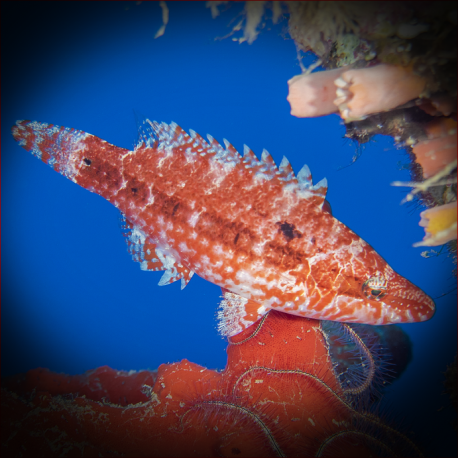More info
Datasheet
| Minimum Tank Size | 800 litres / 211.34 US gallons |
| Maximum Size | 20.0cm / 7.87inches |
| Reef Compatible | Reef safe with caution |
| Temperament | Might be aggressive towards other species |
| Temperature | 22.2°C / 71.96°F - 25.6°C / 78.08°F |
| Specific Gravity | 1.020-1.025 |
| Carbonate Hardness | 8-12 |
| pH | 8.1-8.4 |
General Description
The Mental Wrasse, scientifically known as Oxycheilinus mentalis, belongs to the Labridae family and is commonly found in the Western Indian Ocean, specifically in the Red Sea and Gulf of Aden. These wrasses are known for their vibrant colors and can grow up to 20.0cm in size.
Aquarium Suitability and Demands
With an average level of hardiness, the Mental Wrasse is considered suitable for aquariums with a minimum tank size of 800 liters. However, they can be aggressive towards other species and are known to thrive better when kept on their own in an aquarium.
Care and Hardiness
The Mental Wrasse requires good hiding places, preferably among live rocks, and may initially hide while acclimatizing to its new environment. It is crucial to provide a varied diet to ensure their well-being, as they need a living feed to adapt successfully to tank life. Additionally, these fish enjoy rearranging rocks and sand, so securing the rocks on the substrate is essential to prevent toppling over.
Reef Suitability
Reef enthusiasts can enjoy having the Mental Wrasse in their tanks, as they are considered reef safe with caution. However, they can pose a threat to various invertebrates commonly found in reef ecosystems such as shrimps, crabs, sea urchins, and snails.
Aquarium Setup
For an aquarium housing the Mental Wrasse, it is recommended to maintain stable water conditions with a pH range of 8.1-8.4, a temperature between 22.2-25.6°C, and a specific gravity of 1.020-1.025. Providing ample space in the aquarium is necessary as these fish thrive on swimming and require room for this activity.
Behaviour
Known for their aggressive temperament towards other species, the Mental Wrasse may not be suitable for a community tank setup. They are also documented to jump out of open aquaria, so ensuring a secure lid is crucial to prevent any mishaps.
Feeding and Diet
These wrasses have a diverse diet that includes fish, larger crustaceans like shrimp and crabs, other invertebrates, and small crustaceans such as krill, mysis, and artemia. Offering a varied diet is essential to ensure their nutritional needs are met.
Dimorphism
Unfortunately, there is insufficient information available regarding dimorphism and captive reproduction of the Mental Wrasse. More research is required to understand these aspects of their biology fully.
Habitat and Distribution
In the wild, the Mental Wrasse is predominantly found in the East Indian Ocean, particularly in the Red Sea. Their distribution ranges across the Western Indian Ocean, with habitats encompassing rocky areas where they can hide and exhibit their natural behavior.

